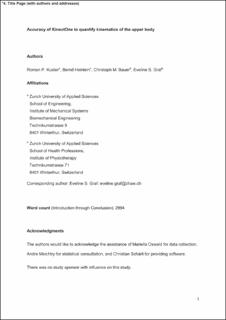Please use this identifier to cite or link to this item:
https://doi.org/10.21256/zhaw-2718| Publication type: | Article in scientific journal |
| Type of review: | Peer review (publication) |
| Title: | Accuracy of KinectOne to quantify kinematics of the upper body |
| Authors: | Kuster, Roman Heinlein, Bernd Bauer, Christoph Graf, Eveline |
| DOI: | 10.21256/zhaw-2718 10.1016/j.gaitpost.2016.04.004 |
| Published in: | Gait & Posture |
| Volume(Issue): | 47 |
| Page(s): | 80 |
| Pages to: | 85 |
| Issue Date: | Jun-2016 |
| Publisher / Ed. Institution: | Elsevier |
| ISSN: | 0966-6362 1879-2219 |
| Language: | English |
| Subjects: | Kinect™ for Xbox One; Kinematics; Upper extremity; Validity; Adult; Biomechanical Phenomena; Female; Humans; Joints; Male; Movement; Range of Motion, Articular; Reproducibility of Results; Torso; Upper Extremity; Software |
| Subject (DDC): | 610: Medicine and health |
| Abstract: | Motion analysis systems deliver quantitative information, e.g. on the progress of rehabilitation programs aimed at improving range of motion. Markerless systems are of interest for clinical application because they are low-cost and easy to use. The first generation of the Kinect™ sensor showed promising results in validity assessment compared to an established marker-based system. However, no literature is available on the validity of the new 'Kinect™ for Xbox one' (KinectOne) in tracking upper body motion. Consequently, this study was conducted to analyze the accuracy and reliability of the KinectOne in tracking upper body motion. Twenty subjects performed shoulder abduction in frontal and scapula plane, flexion, external rotation and horizontal flexion in two conditions (sitting and standing). Arm and trunk motion were analyzed using the KinectOne and compared to a marker-based system. Comparisons were made using Bland Altman statistics and Coefficient of Multiple Correlation. On average, differences between systems of 3.9±4.0° and 0.1±3.8° were found for arm and trunk motion, respectively. Correlation was higher for the arm than for the trunk motion. Based on the observed bias, the accuracy of the KinectOne was found to be adequate to measure arm motion in a clinical setting. Although trunk motion showed a very low absolute bias between the two systems, the KinectOne was not able to track small changes over time. Before the KinectOne can find clinical application, further research is required analyzing whether validity can be improved using a customized tracking algorithm or other sensor placement, and to analyze test-retest reliability. |
| URI: | https://digitalcollection.zhaw.ch/handle/11475/8959 |
| Fulltext version: | Submitted version |
| License (according to publishing contract): | Licence according to publishing contract |
| Departement: | School of Health Sciences |
| Appears in collections: | Publikationen Gesundheit |
Files in This Item:
| File | Description | Size | Format | |
|---|---|---|---|---|
| 2016_Bauer_Accuracy of KinectOne_Gait and Posture.pdf | 305.68 kB | Adobe PDF |  View/Open |
Show full item record
Kuster, R., Heinlein, B., Bauer, C., & Graf, E. (2016). Accuracy of KinectOne to quantify kinematics of the upper body. Gait & Posture, 47, 80–85. https://doi.org/10.21256/zhaw-2718
Kuster, R. et al. (2016) ‘Accuracy of KinectOne to quantify kinematics of the upper body’, Gait & Posture, 47, pp. 80–85. Available at: https://doi.org/10.21256/zhaw-2718.
R. Kuster, B. Heinlein, C. Bauer, and E. Graf, “Accuracy of KinectOne to quantify kinematics of the upper body,” Gait & Posture, vol. 47, pp. 80–85, Jun. 2016, doi: 10.21256/zhaw-2718.
KUSTER, Roman, Bernd HEINLEIN, Christoph BAUER und Eveline GRAF, 2016. Accuracy of KinectOne to quantify kinematics of the upper body. Gait & Posture. Juni 2016. Bd. 47, S. 80–85. DOI 10.21256/zhaw-2718
Kuster, Roman, Bernd Heinlein, Christoph Bauer, and Eveline Graf. 2016. “Accuracy of KinectOne to Quantify Kinematics of the Upper Body.” Gait & Posture 47 (June): 80–85. https://doi.org/10.21256/zhaw-2718.
Kuster, Roman, et al. “Accuracy of KinectOne to Quantify Kinematics of the Upper Body.” Gait & Posture, vol. 47, June 2016, pp. 80–85, https://doi.org/10.21256/zhaw-2718.
Items in DSpace are protected by copyright, with all rights reserved, unless otherwise indicated.